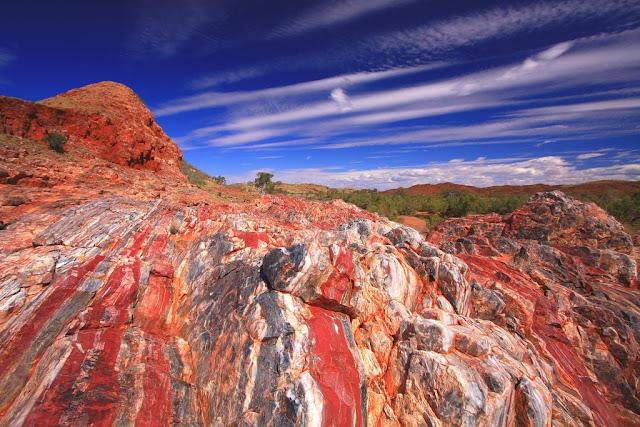There was a time when you grabbed your portable typewriter and you and a photographer headed off to where the news was happening, by whatever means available. And from there you filed your story and images, again by whatever means were available. Not any more.
Today the town of Marble Bar in far north Western Australia (above) is very much in the news. It reached a temperature of 120.2 degrees Fahrenheit (49 Celsius). Tomorrow it will be 118.4 (48). This is how one of Australia's four major television networks plans to cover this newsworthy event, according to a post on Marble Bar's Facebook page:
Marble Bay is in the Pilbara, 917 miles (1476km) from the nearest major capital city, Perth. It's well known for its extremely hot weather. By mean maximum temperatures, it is one of the two hottest places in Australia. Its highest temperature on record was 120.6 (49.2) in January 1922 and its previous highest December temperature was 119.1 (48.4) in 2011.
Marble Bar set a world record of most consecutive days of 100 degrees (37.8) or above during a period of 160 days from October 31, 1923, to April 7, 1924. During December and January, temperatures in excess of 113 degrees (45) are common, and the average maximum temperature exceeds normal human body temperature for six months each year.
Today the town of Marble Bar in far north Western Australia (above) is very much in the news. It reached a temperature of 120.2 degrees Fahrenheit (49 Celsius). Tomorrow it will be 118.4 (48). This is how one of Australia's four major television networks plans to cover this newsworthy event, according to a post on Marble Bar's Facebook page:
"Merry Christmas all! I’m a reporter at 9News and we are hoping to do a story this evening on Marble Bar’s extremely hot weather today. Is anyone willing to share any videos of themselves or their families keeping cool? Or any videos that might illustrate just how hot it is out there? For example, frying an egg on the pavement or vision of your temperature gauge on the 'Welcome to Marble Bar' sign? If you have anything you’d like to contribute – please film it in landscape (ie turn your phone on its side) and email to stwcos@nine.com.au and hopefully we can give it a run on the telly! Thanks in advance!"
Now that's a truly pathetic way of gathering news. But it's what the news industry has come to in the technological age - asking the public to do your work for you, using an iPhone!Marble Bay is in the Pilbara, 917 miles (1476km) from the nearest major capital city, Perth. It's well known for its extremely hot weather. By mean maximum temperatures, it is one of the two hottest places in Australia. Its highest temperature on record was 120.6 (49.2) in January 1922 and its previous highest December temperature was 119.1 (48.4) in 2011.
Marble Bar set a world record of most consecutive days of 100 degrees (37.8) or above during a period of 160 days from October 31, 1923, to April 7, 1924. During December and January, temperatures in excess of 113 degrees (45) are common, and the average maximum temperature exceeds normal human body temperature for six months each year.







4 comments:
The story will probably end up by being an exaggeration of global warming. Ever since digital TV reporting quality on TV has degraded drastically here in the USA. It used to be nothing less than good broadcast quality got on the air in radio or TV. Now any kind of garbage hits the air waves from any one and any kind of device.
Now that was a good news story. It: (1) informed me factually, not wasting my time with cheap opinion; (2) made me feel like I was there (location-wise, not the 120 degrees part); and (3) (not always a criterion): made me want to visit the place! Keep at it. There is still a need and an audience for quality writing.
--Jeff B.
Pennsylvania, USA
This isn't as low as it gets. The ultimate in lazy "news" is when a "reporter" stitches together a "story" out of a few tweets. Often the tweets were not written by anyone of significance, they say nothing of significance, and the entire report is merely about how something was received on Twitter. This is obviously garbage, but I see it often, and in some supposedly reputable publications.
I briefly worked as a reporter in the 1990s, and my publisher would complain every time I left the office to interview someone. “Couldn’t you just use the phone?” she’d ask. No, I would reply, I get a much better interview face-to-face. She relented. And while it is great that with today’s technology anyone can submit a news worthy item, reporters still need to be on the scene. One doesn’t really know a situation unless one experiences it — that’s not always possible, granted, but it’s a reporter’s job to get that experience when possible.
Post a Comment